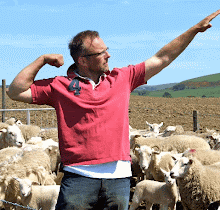Of the five first generation farmers and one third generation (saddled with significant debt at the start) I’ve met so far the over-riding principles are the same - heart (where there’s a will there’s a way); endurance of hardship & resilience (anyone can give up, giving up is easy) and embracing risk (debt is a driver). What differentiated some was how their success was provided in varying economic ways.
Some made it through production. Back in the 1970s, margins were greater. Turnover as a percentage of land value was huge - above 30%. Even now in certain areas of the Western Division of New South Wales a farm can be paid off with its profit from production in perhaps 10 years, given suitable enterprises. Compare this with the UK at current land values and average margins, it might take up to 100 years!
Sheep stations endure very low costs (Vet & Medcine and Feed are quite often zero to a few cents) and have developed systems that require a fraction of the plant and machinery we feel we need in the UK. Freight and fuel are the significant items of expenditure and these can be massive.
Some made it through real estate value increases. By taking on run down properties and improving them significantly a station can double its value with the help of land price increases during that time.
In certain sectors such as cotton the willingness of financial institutions to lend considerable sums (up to 100%) provided one operator the opportunity to build a significant business whilst his property increased in value to help his balance sheet.
Another, Joe Baty, generated cash through Brumbie running and goat mustering and now deals heavily in goats to keep cash flow healthy.
Net Worth - the amount of money they would be left with if everything was sold and debt paid off tomorrow - was almost an obsession with some. This was seen as the bottom line and calculations were made regularly to keep within target or as a measurement of success. Debt was seen as compulsory to be healthy, Equity targets varying in levels from 50% to 80%.
In the Outback I saw the two ways to grow a business - farm production unhampered by distorted markets and asset growth helped by efficient market forces. There is a lot of translation to be done to apply this effectively back in Scotland!









No comments:
Post a Comment